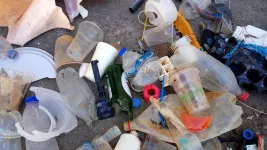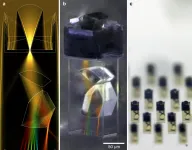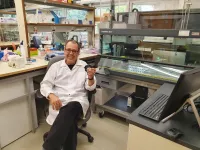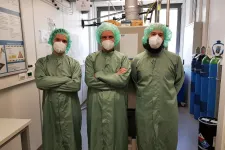Tourism mainly responsible for marine litter on Mediterranean beaches
The global COVID19 pandemic may be an opportunity to rethink the model of sustainable touris
2021-02-08
(Press-News.org) Researchers from the Institute of Environmental Science and Technology of the Universitat Autònoma de Barcelona (ICTA-UAB) warn of the impact the current tourism model in the Mediterranean islands has on the production of marine litter on beaches, and recommend taking advantage of the situation generated by the Covid19 pandemic to rethink a new more sustainable model. The research, recently published in the journal Scientific Reports, shows that the recreational use of Mediterranean island beaches during the summer is responsible for up to 80% of the marine litter accumulating on those beaches, and generates huge amounts of microplastics through the fragmentation of larger plastic items.
The international study led by ICTA-UAB researchers has analysed the effects of waste generated by tourism on eight Mediterranean islands over the past four years. The marine litter, including microplastics, can be defined as any persistent, manufactured or processed solid material discarded, disposed of or abandoned in the marine and coastal environment. It results from human activity and can be found in all the world's oceans and seas. "This environmental issue is threatening the good health of marine ecosystems and can lead to the loss of biodiversity. It can have as well huge economic impacts for coastal communities that depend on ecosystem services by increasing expenditure on beach cleaning, public health or waste disposal", says Dr. Michaël Grelaud, ICTA-UAB researcher and author of the article.
The Mediterranean region welcomes about one-third of the world's tourism every year and is particularly affected by environmental pollution related to this sector. Due to their attractiveness, Mediterranean islands multiply their population by up to 20 during the high season. This represents a challenge for coastal municipalities, which depend on this sector but must adapt and cope with the increase of waste generated, including on the beaches, by the seasonal inflow of tourists. Coastal tourism is indeed expected to be one of the main land-based sources of marine litter.
The amount and type of waste collected was characterized during 147 marine litter surveys conducted during both the low and high tourist season of 2017, on 24 beaches from 8 different Mediterranean islands. The results show that the vast majority of the items collected are made of plastic, as they represent more than 94% of the marine litter.
During the summer, on average 330 items accumulate per 1000m2 of beach per day on the highly popular tourist beaches, 5.7 times more than during the low season. This represents one item every three steps. The number of items most likely left on beaches by the visitors, such as cigarette butts, straws or drink cans, represent more than 65% of the amount of marine litter accumulating on the beaches most popular with tourists. This can increase up to 80% if the large microplastics are included as suggested by the results: during the summer, plastic items left on the beach will undergo fragmentation under the combined effects of solar irradiance and friction with the sand, accelerated by the high volume of visitors. Extrapolated to all the islands of the Mediterranean Sea, the results show that the visitors could be responsible for the accumulation of more than 40 million items per day during the high tourist peak in July and August.
In 2019, and after the implementation of citizen awareness campaigns, the results showed a decrease of more than 50% of the items associated with visitors.
"These very encouraging results probably benefit from the growing attention of the public to the plastic pollution in the oceans or to the measures adopted by the European Commission to reduce marine litter, such as the single-use plastic directive", says Dr. Patrizia Ziveri, ICREA Research Professor at the ICTA-UAB.
In addition, they recall that "the confinement by the COVID19 and the related temporary drastic reduction of tourism offers an opportunity to rethink the fundamental importance of sustainable tourism to ensure a healthy future for the environment and, therefore, also for people", Dr. Patrizia Ziveri concludes.
INFORMATION:
[Attachments] See images for this press release:

ELSE PRESS RELEASES FROM THIS DATE:
2021-02-08
A German-Chinese research team has found a new synthetic route to produce biofuel from biomass. The chemists converted the substance 5-hydroxymethylfurfural (HMF) produced from biomass into 2,5-dimethylfuran (DMF), which could be suitable as a biofuel. Compared to previous methods, they achieved a higher yield and selectivity under milder reaction conditions. The team led by Dr. Baoxiang Peng and Professor Martin Muhler from the Laboratory of Industrial Chemistry at Ruhr-Universität Bochum (RUB) and the group led by Professor Christof Hättig from the RUB Chair for Theoretical Chemistry described the method together with colleagues from Changzhou, ...
2021-02-08
Solar energy is one of the most abundant renewable energy sources, and effective solar technologies have great potential to alleviate the grand challenges of rising global energy demands, while reducing associated emissions. Solar energy is capable of satisfying the electrical and thermal-energy needs of diverse end-users by means of photovoltaic (PV) and solar thermal (ST) technologies, respectively. Recently, hybrid photovoltaic-thermal (PVT) concepts have been proposed that synergistically combine the benefits of PV and ST technologies, and are capable of generating both electricity and useful heat simultaneously from the same area and component.
Spectral splitting is an emerging approach for designing high-performance PVT solar collectors, which employ advanced designs ...
2021-02-08
The molecular details of how SARS-CoV-2 enters cells and infects them are still not clear. Researchers at Uppsala University have tested the bioinformatic predictions made by another research group and have identified receptors that could be important players in the process. The results are presented in the journal Science Signaling and at the AAAS Annual Meeting held this week.
The spike protein of SARS-CoV-2 binds the protein ACE2 on the outside of the human cell. This triggers a series of events that leads to invasion of the cell by the virus. The molecular details of this process have remained obscure ...
2021-02-08
Femtosecond direct laser writing as a 3D printing technology has been one of the key building blocks for miniaturization in modern times. It has transformed the field of complex microoptics since the early 2000s. Especially medical engineering and consumer electronics as vastly growing fields benefit from these developments. It is now possible to create robust, monolithic and nearly perfectly aligned freeform optical systems on almost arbitrary substrates such as image sensors or optical fibers.
Simultaneously, the miniaturisation of spectroscopic measurement devices has been advanced, for instance based on quantum dot or nanowire technology. These are based on computational approaches, which have the drawback of ...
2021-02-08
For decades, the speed of our computers has been growing at a steady pace. The processor of the first IBM PC released 40 years ago, operated at a rate of roughly 5 million clock cycles per second (4.77 MHz). Today, the processors in our personal computers run around 1000 times faster.
However, with current technology, they're not likely to get any faster than that.
For the last 15 years, the clock rate of single processor cores has stalled at a few Gigahertz (1 Gigahertz = 1 billion clock cycles per second). And the old and tested approach of cramming ...
2021-02-08
In diagnostic medicine, biopsies, where a sample of tissue is extracted for analysis, is a common tool for the detection of many conditions. But this approach has several drawbacks - it can be painful, doesn't always extract the diseased tissue, and can only be used in a sufficiently advanced disease stage, making it, in some cases, too late for intervention. These concerns have encouraged researchers to find less invasive and more accurate options for diagnoses.
Professor Nir Friedman and Dr. Ronen Sadeh of the Life Sciences Institute and School of Computer Engineering have published a study in Nature Biotechnology that shows how a wide range of diseases can be detected through a simple ...
2021-02-08
In certain materials, electrical and mechanical effects are closely linked: for example, the material may change its shape when an electrical field is applied or, conversely, an electrical field may be created when the material is deformed. Such electromechanically active materials are very important for many technical applications.
Usually, such materials are special, inorganic crystals, which are hard and brittle. For this reason, so-called ferroelectric polymers are now being used. They are characterised by the fact that their polymer chains exist simultaneously in two different microstructures: some areas are strongly ...
2021-02-08
A study has described genetic changes in patients with the most common form of hereditary kidney disease that affects an estimated 12.5 million people worldwide. The research, which focussed on Polycystic Kidney Disease (PKD) in Ireland, provides insights into PKD that will assist doctors and patients in the management of this of inherited condition.
The study, led by researchers from the RCSI University of Medicine and Health Sciences, is published in the European Journal of Human Genetics.
In the research, a cohort of 169 patients with PKD in Ireland were analysed. The genetic changes were identified in up ...
2021-02-08
Results from a new study which draws on survey data collected during the peak of the first wave of the pandemic suggests that being forced to slow down life, as a consequence of lockdown, has had significant, positive impacts for many people and their families.
The research, recently published in the British Journal of Psychiatry from a team at the University of Bath with international colleagues, analysed survey results from 385 caregivers of children aged 6-16 both in the UK and Portugal. Individuals completed an online questionnaire between 1 May 2020 and 27 June 2020.
This cohort had ...
2021-02-08
Swapping the car for walking, cycling and e-biking even just one day a week makes a significant impact on personal carbon emissions in cities.
'Active transport' - cycling, e-biking or walking - can help tackle the climate crisis according to a new study led by the University of Oxford's Transport Studies Unit and including researchers from Imperial's Centre for Environmental Policy as part of the EU-funded project PASTA: Physical Activity Through Sustainable Transport Approaches.
Meeting greenhouse gas emissions reduction targets requires a significant move away from motorised transport. The team found that shifting to active transport could save as ...
LAST 30 PRESS RELEASES:
[Press-News.org] Tourism mainly responsible for marine litter on Mediterranean beaches
The global COVID19 pandemic may be an opportunity to rethink the model of sustainable touris




